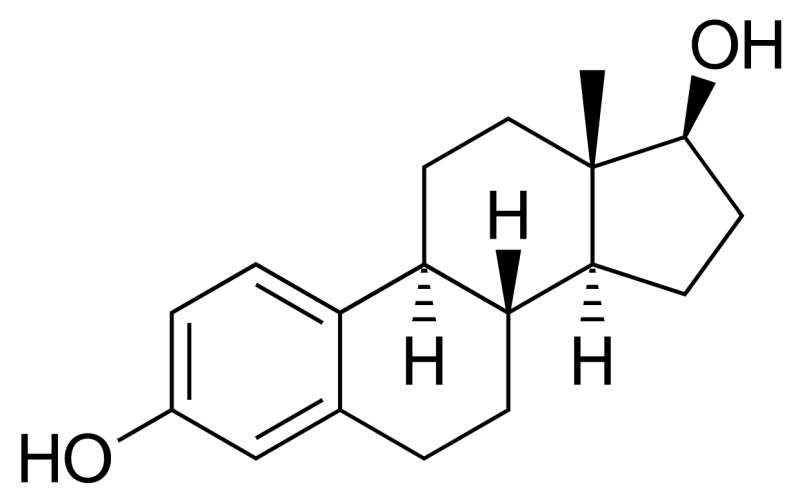Estradiol, the major estrogen sex hormone in humans and a widely used medication. Credit: Public Domain
Perfluoroalkyl substances (PFASs) have received intense scrutiny in recent years because of their persistence in the environment and potential endocrine-disrupting effects. However, their estrogenic activities are controversial, with different studies showing apparently contradictory results. Now, researchers reporting in ACS' Environmental Science & Technology have used a combination of laboratory experiments and computer modeling to reveal that PFASs can interact with the estrogen receptor in different ways to influence estrogen-controlled gene expression.
PFASs have been widely used in a variety of household products, including non-stick coatings, polishes, fire-retardant foams and stain-repellant finishes for fabrics. These long-lasting compounds are pervasive in the environment and have been detected in wildlife and humans. In the lab, some PFASs appear to mimic estrogen under certain conditions by binding and activating the estrogen receptor, but they seem to block the hormone's signaling under others. Aiqian Zhang, Jianjie Fu and colleagues wanted to delve deeper into these seemingly contradictory results by studying interactions between various PFASs and the human estrogen receptor, in the presence or absence of the hormone itself. The team reasoned that because estrogen binds much more strongly to its receptor than PFASs, the pollutants probably couldn't completely displace estrogen from the receptor.
The researchers tested the estrogenic and anti-estrogenic behaviors of 10 PFASs using human cells. They found that two of the compounds mimicked estrogen's ability to activate transcription, whereas three others inhibited expression of a reporter gene. However, when the researchers also added estrogen to the cells, all of the compounds blocked the natural hormone's activity. To understand why, the researchers developed a computational model to explore how PFASs bind to the estrogen receptor under different conditions. The model predicted that all of the PFASs could bind to sites on the receptor surface that were distinct from where estrogen binds, including in a groove where coactivators—which boost the activation of the receptor in the presence of estrogen—attach. These findings suggest that some PFASs can bind and activate the estrogen receptor when the hormone isn't around, but when it is, the compounds bind to other regions of the receptor, potentially blocking its action, the researchers say.
More information: "Evaluation of the Estrogenic/Antiestrogenic Activities of Perfluoroalkyl Substances and Their Interactions with the Human Estrogen Receptor by Combining In Vitro Assays and In Silico Modeling" Environmental Science & Technology (2020). pubs.acs.org/doi/abs/10.1021/acs.est.0c03468
Journal information: Environmental Science & Technology
Provided by American Chemical Society
























